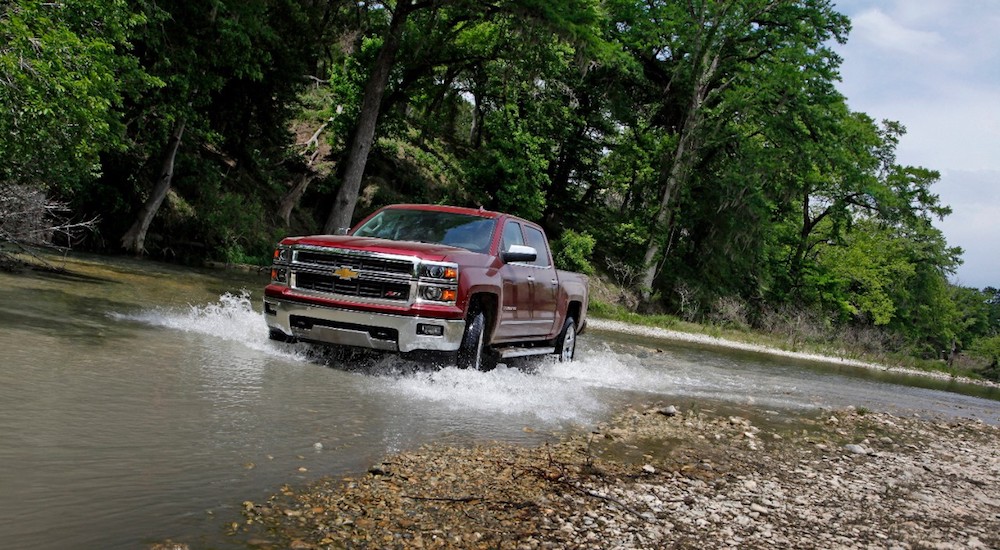In a world where the idea of $100K trucks is becoming more commonplace, one can’t help but think back to a simpler time when trucks were accessibly-priced, and designed simply to ‘get the job done’. Don’t get me wrong, I’m not complaining about the thorough and well-realized offerings that continually elevate the truck segment to near luxury-level offerings, but the simple truth is that even base level offerings are becoming so well-equipped that they’re edging ever so slightly out of many peoples’ price range. It’s one of the many reasons that so many prospective buyers might consider used Chevy trucks as opposed to the newest models of either the Silverado or Colorado.
But of those two models, which model years earn our pick for the best all-around version of each? Well, let’s take a closer look.
Our Pick for Pre-Owned Silverado
It’s all about balance, right? The perfect mix of capability, amenity, design and price tag. And with that in mind, our pick for a pre-owned Silverado (price tag notwithstanding) would have to go the 2015 Silverado 1500. Representing the sophomore year of the 3rd-generation Silverado, it strikes a perfect balance of evolving technology and palatable price point.
In fact, we’ll even take it a step further to specify the LT trim level with an extended cab. Not only do you score the assurance of a 5-Star Safety Rating from NHTSA, but you get a really well-equipped full-size truck. Offered with three powertrains, you can opt for the (i) 285hp 4.3-liter V6 (ii) 355hp 5.3-liter V8 or (iii) 420hp 6.2-liter V8. Depending on the configuration selected, this scores you up to 1,850 lbs in available payload, and a towing capacity of up to 9,200 lbs.
On top of that, you’ll find the option of OnStar connectivity (including 4G LTE WiFi) and a touchscreen interface with the convenience of a rear-facing camera. All in all, it’s a well-equipped truck, removed enough to offer some savings, and new enough to include a few bells and whistles.
Our Pick for Pre-Owned Colorado
Truth be told, we’re not as passionate historically about the Colorado as we are about its upsized sibling. That said, a mid-size offering is compelling in its own right, appealing to the demographic that it’s designed to target.
So, if we were among those tempted by the Colorado, which model year offering would secure our buying dollar? Well, even with its relative newness, we’d be inclined to favor the 2017 Colorado configured with a four-door crew cab.
Of course, the perk of newness is the technology, and the ’17 Colorado comes standard with all the tech-centric features mentioned above albeit with a slightly upsized (5.2-inch) touchscreen. This, combined with a 2.5-liter four-cylinder capable of 200hp, deliver an ideal offering for anyone less interested in a ‘do-it-all pickup’ requiring only modest capability, but in need of easy catlike drivability.
So there you have it, two solid picks to use as a starting point if you’re in the market for used Chevy trucks. And with that out of the way, let’s talk about some of the reasons why the decision to buy pre-owned is so fiscally sound.
Appreciating Depreciation
As part of the wider picture, depreciation could be summarized as a means of reducing the perceived value of any asset allowing us to make room for newer, advanced and more capable products. But since it’s a very real facet of our collective existence, it’s important to understand how it plays out through our various depreciable assets, and if there’s any way to make it work it in our favor. And if we’re looking to do so, vehicles are a great place to start.
At some time or another, you’ve probably heard someone mention that a brand new vehicle begins to lose its value the moment that it’s driven off the lot. And while it’s easy to brush off such a statement (especially since there are laws and regulations in place to protect consumers) the statement, as a whole, is true. New vehicles lose as much as 11% of their value before the rear tires even hit the pavement. Setting aside the aforementioned protections, it means that a new buyer could turn right back into the dealer’s lot, attempt to sell a $30,000 vehicle back to the dealership, and they’d only be entitled to less than $27,000. This scenario would, of course, play out differently in the ‘real world’ but you get the point: vehicles lose value, and it starts to happen almost immediately.
Depreciation happens at a more aggressive rate in new vehicles (versus used) and that rate of depreciation slows with each year. Within the first year alone, that $30,000 vehicle would have decreased in value by roughly 25%. After three years? A 46% decrease in value would place its value around the $16,000 mark. And after five years of ownership it might only be valued at $11,000 (a drop of as much as 63%).
So, if you’re looking for a better understanding of who gets screwed by depreciation, it’s the original owner of a brand new vehicle. Granted, it’s likely that they’ll enjoy that vehicle through most of its trouble-free years, but the financial return, not that original investment, is bound to be disappointing.
On the other hand, who benefits from depreciation? The secondary owner. This is especially true if that vehicle is well-maintained by the original owner, and resold within the first five years. While the secondary owner will inevitably pay the dealer’s markup, they are still likely to receive ‘more car for their money’, able to afford a more expensive model or well-equipped trim level than if they had attempted to buy it new. It simply comes down to the buyer’s willingness and ability to perform their own due diligence, to ensure that the purchase is a wise investment overall.
But the savings extend beyond the sales price. They also include up-front and incremental costs that add to the expense of a vehicle across its entire lifetime. For example: title, tax and registrations costs (depending on the state) are likely to be lower on a used vehicle. In addition, the cost of insuring that vehicle will be lower, overall.
“But what about increasing repair costs?”
Okay, you’ve got us there. Yes, expenses related to repair and preventative maintenance will inevitably increase as a vehicle grows older. That’s just common sense. However, that just cycles back to our previous mention of due diligence that should be performed at the time of purchase. A thorough inspection of the vehicle by a trained eye can help to (i) detect problematic areas in the vehicle or (ii) disqualify a vehicle that will be more trouble than its worth. Physical inspection, along with a review of a vehicle history report, are key elements of ensuring your personal satisfaction with any pre-owned purchase.
Considering a Used Truck?
Bottom-line, if you’re considering used Chevy trucks, you’re far from alone. The value of pre-owned vehicles combined with the ever-expanding array of features that Chevy (and other automakers) have added in recent years make for powerful incentives, and more people than ever are choosing late-model offerings in appreciation of the value that they offer. Simply put, it’s smart.





